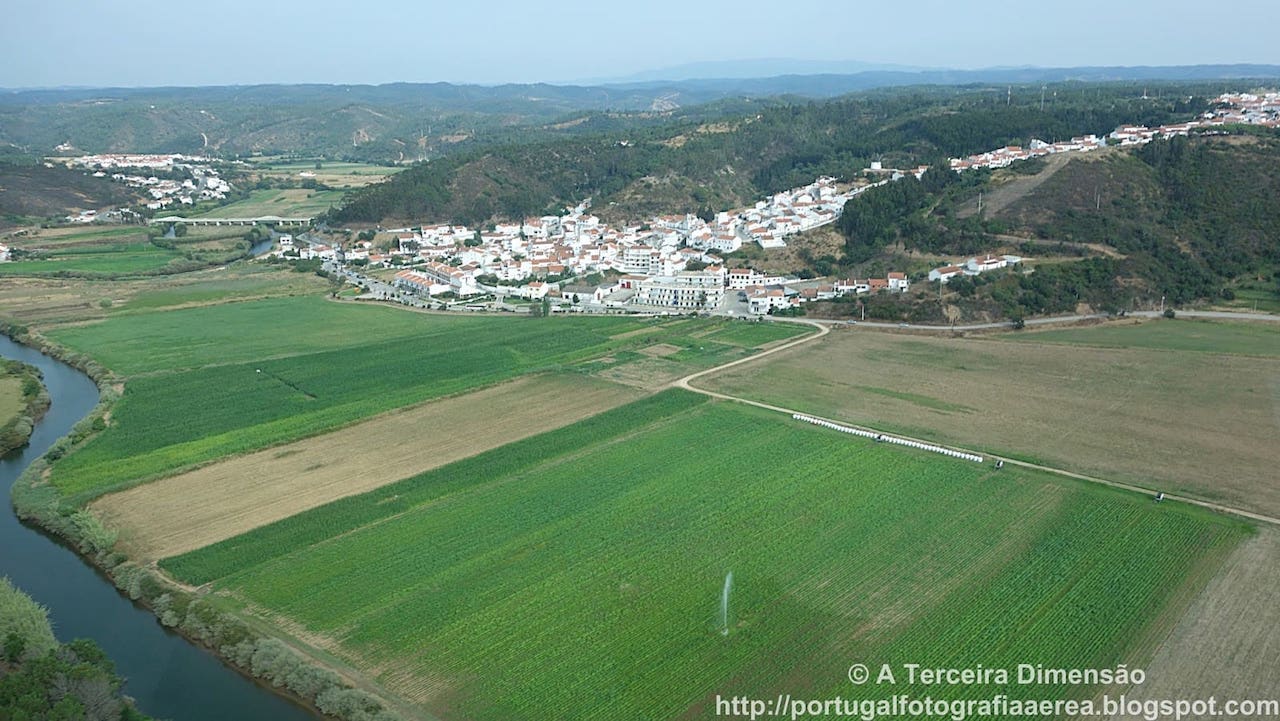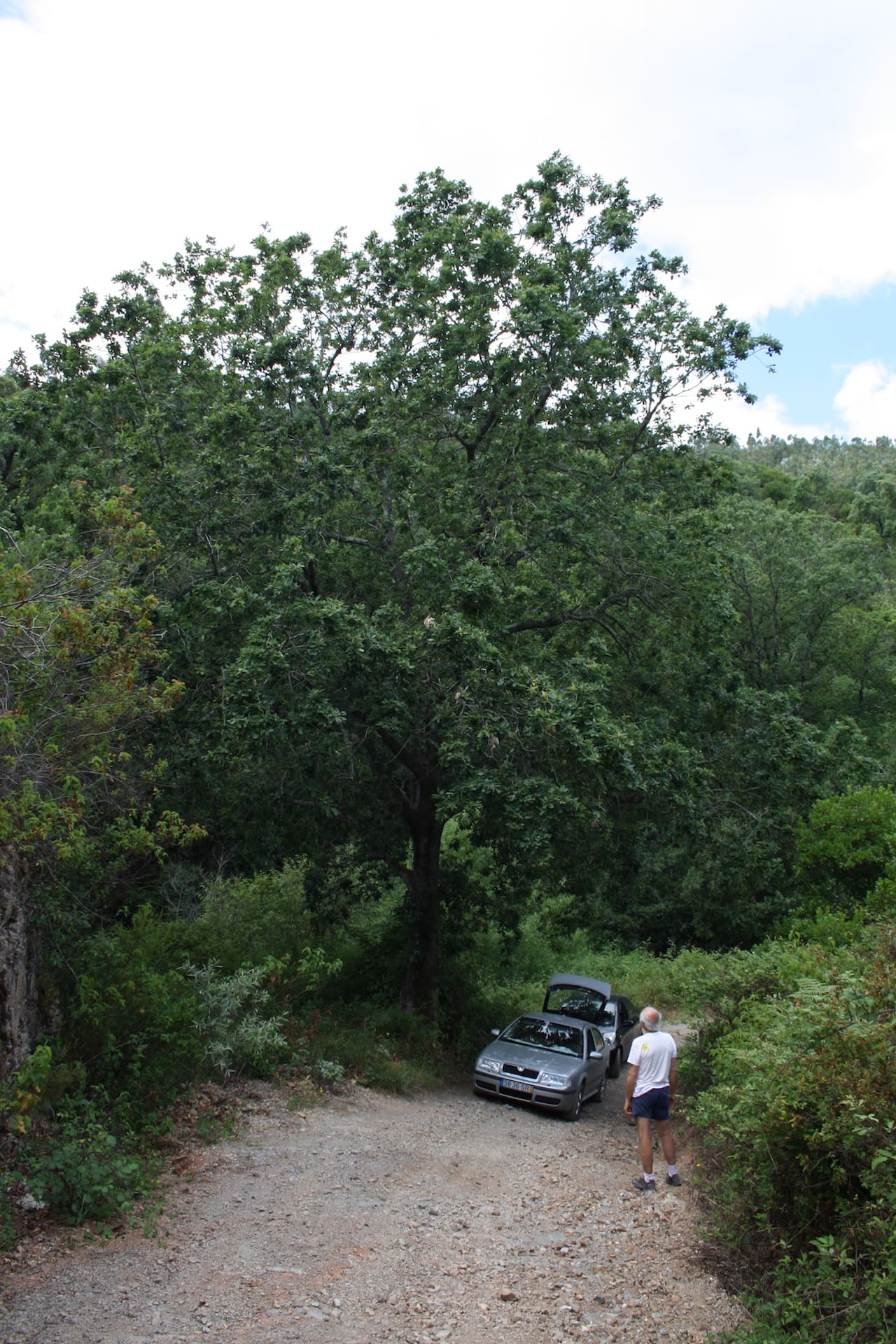Context
The TerraSeixe Project arose from concerns about the precarious state of conservation of the Seixe River basin. Of particular note was the Monchique oak (Quercus canariensis), an endemic species that, despite the small number of specimens, exists in this valley in greater numbers than anywhere else in Portugal. Furthermore, in the flora and fauna of the Seixe watershed, there is a series of other unusual species and even some vestiges of increasingly rare Laurisilva forests, all today in a state of deep degradation.


(Source: A Terceira Dimensão).
 The TerraSeixe Project team next to a Monchique Oak on a track in the Seixe valley. (Image: J. Roborg-Söndergaard).
The TerraSeixe Project team next to a Monchique Oak on a track in the Seixe valley. (Image: J. Roborg-Söndergaard).
Quercus canariensis, Portugal’s second largest native tree is emblematic of the TerraSeixe initiative. Fragments survive in Spain and in the mountains of northwest Africa. The best ornamental specimens are found in gardens in Australia and New Zealand.
 Trail through Mediterranean woodland in the basin. (Image: J. Roborg-Söndergaard).
Trail through Mediterranean woodland in the basin. (Image: J. Roborg-Söndergaard).
This type of Mediterranean forest is found near creeks in the Seixe valley where vestiges of ancient Laurisilva habitat where laurel trees (Laurus nobilis) may be found. In Europe, these much-diminished forests exist in mainland Portugal, Madeira Island and Spain.
 Inland winter landscape of the Seixe river which flows from the Monchique mountains to Portugal’s west coast. (Image: J. Roborg-Söndergaard).
Inland winter landscape of the Seixe river which flows from the Monchique mountains to Portugal’s west coast. (Image: J. Roborg-Söndergaard).
The project covers the entire Seixe hydrographic basin. In theory three Nature Conservation Instruments furnish an overlapping legal framework to protect 90 percent (229 km²) of the 254 km² that make up the river watershed [1, 2, 3]

(Source: M. Jerónimo, 2018: GEOTA).
The Natura 2000 Network’s main aim is “to ensure the long-term survival of Europe’s most valuable and threatened species and habitats, listed under both the Birds Directive and the Habitats Directive.”
It is not, nevertheless, “a system of strict nature reserves from which all human activities would be excluded. While it includes strictly protected nature reserves, most of the land remains privately owned. The approach to conservation and sustainable use of the Natura 2000 areas is much wider, largely centred on people working with nature rather than against it. However, Member States must ensure that the sites are managed in a sustainable manner, both ecologically and economically.” (https://ec.europa.eu/environment/nature/natura2000/index_en.htm#:~:text=Natura%202000%20is%20a%20network,on%20land%20and%20at%20sea.) And here, as with the Seixe’s Important Bird Area (IBA) status which is similarly aims “to secure the long-term conservation of sites that are of significant importance for birds and biodiversity” Portugal fails conspicuously – over 40% of the “protected” area is industrial monotypic eucalyptus plantation.

(Source: M. Jerónimo, 2018: GEOTA).
In addition, along the coast there is another overlapping protected area, the Southwest Alentejo and Costa Vicentina Natural Park, which covers 9 km² (or 3.5 percent) of the Ribeira de Seixe Watershed [1]. This is the land of the Seixe river’s estuary which belongs to Portugal’s National Network of Protected Areas. The aim of this park is likewise to support “conservation, legislation, planning and management” [4].

(Source: M. Jerónimo, 2018: GEOTA).
Despite all these initiatives aimed at conserving natural heritage, the density of eucalyptus plantations is over 40% and continues to grow. Instead of conserving and protecting habitats and their endemic species, these plantations are increasingly replacing supposedly protected natural habitats.

(Image: J. Roborg-Söndergaard).
A sparsely inhabited watershed such as the Seixe river basin must be understood as a multifunctional landscape. According to the European Landscape Convention, landscapes are zones observed by people whose characteristics result from the action and interaction of natural and/or human factors [5]. Through this approach to the watershed, the TerraSeixe Project proposes that this landscape be interpreted as a source of benefits, goods and services provided by the environment. This implies that, in the management of the hydrographic basin, both human aspirations and ecological needs are recognised.
Such an approach might resolve any conflicts that arise not only between the human inhabitants of the river basin, but also between current land exploitation activities and those that are compatible with the Nature Conservation Instruments (ICNs in Portuguese). If this balance between human activity on the one hand and natural habitats and species on the other can be achieved, it may finally be possible to ensure the protection and conservation of wildlife.
REFERÊNCIAS
[1] Ferreira AI, Jerónimo M. (2015) Instrumentos de Conservação da Natureza na Bacia Hidrográfica da Ribeira de Seixe. Lisboa: GEOTA.
[2] Instituto da Conservação da Natureza e das Florestas (ICNF) Natura 2000. Disponível em: http://www2.icnf.pt/portal/pn/biodiversidade/rn2000.
[3] Instituto da Conservação da Natureza e das Florestas (ICNF) Aves. Disponível em: http://www2.icnf.pt/portal/pn/biodiversidade/rn2000/p-set/psrn-aves.
[4] Instituto da Conservação da Natureza e das Florestas (ICNF) Áreas Protegidas: 12. Disponível em: http://www2.icnf.pt/portal/ap.
[5] The European Landscape Convention of the Council of Europe. Disponível em: https://www.coe.int/en/web/landscape.


